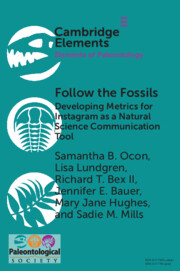58 results
Genomic investigation of multispecies and multivariant blaNDM outbreak reveals key role of horizontal plasmid transmission
-
- Journal:
- Infection Control & Hospital Epidemiology / Volume 45 / Issue 6 / June 2024
- Published online by Cambridge University Press:
- 12 February 2024, pp. 709-716
- Print publication:
- June 2024
-
- Article
-
- You have access
- Open access
- HTML
- Export citation
Self-reported reasons for reducing or stopping antidepressant medications in primary care: thematic analysis of the diamond longitudinal study
-
- Journal:
- Primary Health Care Research & Development / Volume 24 / 2023
- Published online by Cambridge University Press:
- 27 February 2023, e16
-
- Article
-
- You have access
- Open access
- HTML
- Export citation
Effectiveness of community-based livestock protection strategies: a case study of human–lion conflict mitigation
-
- Article
-
- You have access
- Open access
- HTML
- Export citation

Follow the Fossils
- Developing Metrics for Instagram as a Natural Science Communication Tool
-
- Published online:
- 10 November 2021
- Print publication:
- 09 December 2021
-
- Element
- Export citation
The mustatils: cult and monumentality in Neolithic north-western Arabia
-
- Article
-
- You have access
- Open access
- HTML
- Export citation
342 - The Dementia Early Stage Cognitive Aids New Trial (DESCANT) intervention: Goal Attainment Scaling
-
- Journal:
- International Psychogeriatrics / Volume 32 / Issue S1 / October 2020
- Published online by Cambridge University Press:
- 04 November 2020, p. 102
-
- Article
-
- You have access
- Export citation
Patient-level predictors of detection of depressive symptoms, referral, and uptake of depression counseling among chronic care patients in KwaZulu-Natal, South Africa
-
- Journal:
- Global Mental Health / Volume 7 / 2020
- Published online by Cambridge University Press:
- 21 July 2020, e18
-
- Article
-
- You have access
- Open access
- HTML
- Export citation
Seymour (Marambio) Island: an outstanding example of Antarctic geological heritage
-
- Journal:
- Antarctic Science / Volume 32 / Issue 3 / June 2020
- Published online by Cambridge University Press:
- 13 May 2020, p. 167
-
- Article
-
- You have access
- HTML
- Export citation
The challenges of commissioning home care for older people in England: commissioners’ perspectives
-
- Journal:
- Ageing & Society / Volume 41 / Issue 8 / August 2021
- Published online by Cambridge University Press:
- 21 February 2020, pp. 1858-1877
- Print publication:
- August 2021
-
- Article
- Export citation
Specialist healthcare services for UK care home residents: a latent class analysis
-
- Journal:
- Primary Health Care Research & Development / Volume 20 / 2019
- Published online by Cambridge University Press:
- 16 September 2019, e132
-
- Article
-
- You have access
- Open access
- HTML
- Export citation
13 - Alas the Storm Has Come Again!
- from Part III - Climate Change in the Anthropocene
-
-
- Book:
- Primate Research and Conservation in the Anthropocene
- Published online:
- 25 January 2019
- Print publication:
- 31 January 2019, pp 237-256
-
- Chapter
- Export citation
Reconfiguring in-patient services for adults with mental health problems: changing the balance of care
-
- Journal:
- BJPsych Open / Volume 4 / Issue 6 / November 2018
- Published online by Cambridge University Press:
- 15 October 2018, pp. 420-426
-
- Article
-
- You have access
- Open access
- HTML
- Export citation
Evaluating the effectiveness of different approaches to home support for people in later stage dementia: a protocol for an observational study
-
- Journal:
- International Psychogeriatrics / Volume 29 / Issue 7 / July 2017
- Published online by Cambridge University Press:
- 07 March 2017, pp. 1213-1221
-
- Article
- Export citation
Notes on Contributors
-
- Book:
- Writing the Nigeria-Biafra War
- Published by:
- Boydell & Brewer
- Published online:
- 17 June 2021
- Print publication:
- 15 July 2016, pp viii-xiv
-
- Chapter
- Export citation
Index
-
- Book:
- Writing the Nigeria-Biafra War
- Published by:
- Boydell & Brewer
- Published online:
- 17 June 2021
- Print publication:
- 15 July 2016, pp 486-491
-
- Chapter
- Export citation
Map of Biafra 30 May 1967 – 1 May 1969
-
- Book:
- Writing the Nigeria-Biafra War
- Published by:
- Boydell & Brewer
- Published online:
- 17 June 2021
- Print publication:
- 15 July 2016, pp xx-xx
-
- Chapter
- Export citation
Part III - The War In Fiction, Memoir, And Imagination
-
- Book:
- Writing the Nigeria-Biafra War
- Published by:
- Boydell & Brewer
- Published online:
- 17 June 2021
- Print publication:
- 15 July 2016, pp 207-208
-
- Chapter
- Export citation
Contents
-
- Book:
- Writing the Nigeria-Biafra War
- Published by:
- Boydell & Brewer
- Published online:
- 17 June 2021
- Print publication:
- 15 July 2016, pp v-vii
-
- Chapter
- Export citation
Frontmatter
-
- Book:
- Writing the Nigeria-Biafra War
- Published by:
- Boydell & Brewer
- Published online:
- 17 June 2021
- Print publication:
- 15 July 2016, pp i-iv
-
- Chapter
- Export citation
Select Bibliography
-
- Book:
- Writing the Nigeria-Biafra War
- Published by:
- Boydell & Brewer
- Published online:
- 17 June 2021
- Print publication:
- 15 July 2016, pp 477-485
-
- Chapter
- Export citation

